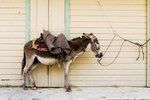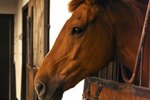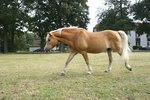In the United States, donkeys are primarily classified by size rather than breed. Still, specific breeds of donkey do exist, although with industrialization and mechanization, most of these are rare and endangered.
Mammoth Donkeys
The largest of donkeys, the mammoth donkey matures at 14 hands and taller for males, or jacks, and 13.2 hands and above for jennies. That's 56 inches and 54 inches or more, respectively. While the mammoth donkey's traditional role has been in the breeding of mules -- a cross between a horse and donkey -- there's no reason a mammoth donkey can't be ridden. Like their mule offspring, mammoth donkeys are generally calmer than horses and make good riding or driving animals for those enjoying leisurely outings.
Standard Donkeys
Standard donkeys fall into three separate types, based on size.
- The small standard ranges between 36 and 40 inches high at the withers.
- The standard donkey stand between 40 and 48 inches tall.
- The large standard ranges between 48 and 54 inches for jennies, and 48 and 56 inches for jacks.
Miniature Donkeys
Also known as Mediterranean, Sardinian or Sicilian donkeys, these small donkeys were used by the peasantry in their native lands for various tasks. While few of them remain in Italy and other areas of the Mediterranean, they are fairly common in North America as pets.
While too small for anyone but young children to ride, miniature donkeys make suitable driving animals. Miniature donkeys can't exceed 36 inches in height at the withers.
Poitou Donkey
You won't mistake the hairy Poitou donkey for any other type. For most of his existence, this large French donkey was used primarily for creating mules. At maturity, Poitous are just slightly smaller than the mammoth donkey. They are rare today, with perhaps a few hundred still in existence.
Unlike other donkeys, Poitous don't carry a cross pattern on their backs. While the Poitou is always brown or black, he sports a white nose and a grey abdomen.
Other Rare Breeds
In Spain, the numbers of the Catalan, the larger Andaluz and the much larger Zamorano-Leones donkey are dwindling. The Parlag donkey, from Hungary, is also in decline although hobby breeders are keeping their lines alive. In France, hobby breeders are also helping to reestablish the Cotentin donkey, who once transported milk from dairies.
References
Writer Bio
Jane Meggitt has been a writer for more than 20 years. In addition to reporting for a major newspaper chain, she has been published in "Horse News," "Suburban Classic," "Hoof Beats," "Equine Journal" and other publications. She has a Bachelor of Arts in English from New York University and an Associate of Arts from the American Academy of Dramatics Arts, New York City.





